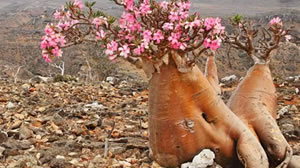| 5 Adenium Obesum seeds We are getting over 80% germination Common names include Desert Rose, Elephants Foot, Impala Lily, Mock Azalea, Kudu, Sabi Star Provided with growing and care guide link DO NOT OVERWATER The photo shows a mature plant in flower and some seeds Description:
Adenium obesum is a succulent shrub or small tree belonging to the the oleander family. It has a pachycaul stems and a stout, swollen basal caudex with an opened crown becoming denser with age. It is evergreen or drought-deciduous and can also lose its leaves during cold spells. It is quite variable in habit and most plants in cultivation are hybrids, yet only a few cultivar names have a valid description. It is monoecious and self-sterile. Stem:
2–4 (-6) m tall, but usually much smaller, fleshy, with a distinct irregular swollen base, or caudex up to 1 (-2) m in diameter, much of which is underground. Above ground the caudex can be globose to conical with smooth, pale greyish-green to brown bark. In mature specimens a definite caudex may no longer be recognizable as the it forms a swollen trunk with few irregularly thickened branches. The branches are smooth, greyish-green, pubescent at apex and usually upright, tortuous and irregularly spaced but sometime they are weak and spreading. The plant contains a copious sticky watery or white sap that flows from broken stem as well as from other plant parts like leaves, roots etc. Roots:
Fleshy taproot. Leaves:
Spirally arranged, clustered toward the tips of the shoots, scentless, simple entire, spathulate to obovate, fleshy, leathery in texture, hairless, shiny dark green to bluish-green above, paler green and dull below, (3-)5–12(-17) cm long and (0,5-)1–6(-8) cm broad. The apex is rounded and the base tapers into a very short petiole usually less than 2 mm long. Flowers:
Bisexual, regular, very showy and arranged in - more or less - dense, cymes that stay above the leaves, tubular with flared lips 2–5 cm long, with the outer portion 4–6 cm diameter with five petals and wavy or crinkled margins. The flowers range from red through pink to white, often with a whitish blush outward of the throat. Sepals oval 6-12 mm long, pedicel 5-9 mm long. Blooming time:
It is capable of flowering all year, even sparingly during the winter, but it is more floriferous during the dry periods of Spring and Autumn. Flowers appear often before leaves on deciduous branches, and for a time the crown is adorned only with flowers as new leaves emerge below the flowers. The flowers opening for 2-3 days. Fruit:
The fruit is a twin follicle about 10-22 cm long resembling the horns of a steer. The two follicles are united at the base, narrowly oblong, slightly recurved, pale grey-green to grey-brown, and tapering at both ends. When matured, the follicles dehisce (split) along one side to release the seeds. Seeds:
Long narrow cylindric, 10-14 mm long, brown slightly scabrid, with long silky dirty-white to golden-brown hairy tuffs (pappus) at each end so that the seed is blown along the ground like an axle with two wheels. - Out of Stock
|



